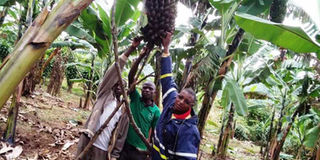Banana diseases giving farmers sleepless nights

Farmers show the bunch of banana which has been infected with a strange disease. File photo
What you need to know:
Outbreak in the region is significant because western Uganda produces more than 60 per cent of bananas consumed in the country, writes Lominda Afedraru.
The banana plant is one of the cash crops in the country though its survival in farm fields is now being threatened by pests and diseases which keep emerging due to climate change challenges.
This is driving some of the varieties off farmer’s list since it is becoming less profitable due to low yields.
The plant is a staple food in East and Central Africa and provides approximately 20 per cent of the total calorie consumed per capita.
Uganda and Tanzania are the two main producers of bananas in the region, mainly through the cultivation of the East African Highland bananas (EAHB).
Production of bananas in the region however has declined since the 1970s and now yields a fraction of its potential.
According to the World Bank 2010 data collection, while low yields are partly due to poor soil fertility in the region, pests and diseases have played a significant role in reducing banana yields.
Apart from the previous reported diseases including banana bacterial wilt which is the most deadly, a new disease has emerged in fields in western Uganda where the plant is grown most.
The disease believed to be in the anthracnose fungal category shows symptoms of blackening the banana fingers but does not affect the entire plant.
Jerome Kubiriba, an entomologist at the National Agriculture Research Laboratories (NaRL), explains that this disease is not a major challenge because the blackened banana fingers occurs on the out part of the peel.
Once the banana is peeled, the inner part is fine and can be cooked and consumed without causing any harm.
“The black spots on the banana peel is caused by a specific insect which keeps scratching and making black fungal coat spots on the peel,” says Kubiriba.
Other diseases
The fusarium wilt
It is caused by soil borne fungus known as Fusarium Oxysporum and destruction rate on a farm is 100 per cent wiping the entire plant in the field by wilting.
It causes the browning of the internal stem vascular tissue. It is a destructive soil borne disease of bananas present in all banana producing countries in sub Saharan Africa. The disease was first discovered in Australia in 1876 but it became prominent when it almost destroyed the international banana export industry.
On the outside of affected stems, white, pink or orange fungal growth can be seen especially in wet conditions.
It was discovered in Uganda in 1970 and it affects mainly the sweet varieties namely Sukari Ndizi, Kayinja and Bogoya.
Black sigatoka
It is a leaf spot disease of banana plants caused by the Mycosphaerella fijiensis fungus which is spread by rain, wind and irrigation water. It causes drying and blackening of leaves and it becomes difficult for photosynthesis to take place.
Once a plant is infected it leads to incomplete filling of banana fingers. It was first reported in Fiji is 1960’s and spotted in Uganda in 1989 becoming a serious challenge in 2005.
Streak virus
It is a viral disease known to be affecting banana varieties such as Musa and Ensete. It is spread by insects such as mealybugs and through seed. It causes chlorotic streaks on the leaves which retards photosynthesis.
Banana bacterial wilt
The disease is characterised by the yellow- orange discoloration of the vascular bundles and dark brown tissue scarring. The symptoms on the inflorescence include a gradual wilting and yellowing of the leaves plus wilting of the stem and shrivelling of the male bud.
It is known to be one of the deadly diseases causing 100 per cent yield loss on farmer fields. It was first reported in farmer fields in Ethiopia in 1970’s. In Uganda it was first reported in Mukono in 2001 before spreading to other parts of the country. It affects all banana varieties.
Remedy
Experts recommend farmers to observe the following practices in trying to combat the diseases in their farms.
Use of resistant cultivars is the most recommended remedy.
Farmers are also encouraged to observe practices such as crop rotation, mulching, timely weeding, plating on raised beds and avoiding overhead irrigation. Agronomists also recommend use of disinfect gadgets for pruning and cutting banana stems such as machete.
Banana pests
According to Josephine Namaganda a specialist at NaRL in breeding banana for pest resistance, the major pests farmers should look out for include nematodes and weevils. These pests have potential of wiping the entire garden.
Nematodes
They are tinny insects which can be seen by use of microscope breeding in the soil. These insects attack the banana from the root causing rotting.
There are different types namely root rot nematodes, burrowing nematodes, leison nematodes and reniform nematodes among others.
Weevils
Weevils infest the banana plant at the base of the outermost leaf-sheath and in injured tissues at the lower part of the pseudo stem.
“Initially the young grubs make several longitudinal tunnels in the surface tissue until they are able to penetrate to adjacent inner leaf-sheaths,” says Namaganda.
Infested plants have dull yellow green and floppy foliage. Young infested suckers often wither and fail to develop flowers. Plants are easily blown down by mild to strong winds.
Management
Namaganda advices farmers to plant resistant materials. She says the team at NaRL has been breeding hybrid varieties using conventional method. In 2018 they were able to release four varieties resistant to nematodes and weevils and tolerant to banana sigatoka disease namely Naroban 1, 2, 3 and 4. In 2019 Naroban 5 hybrid matooke variety was also released to farmers.
She advises farmers to plant these varieties.
Other traditional methods include crop rotation, farmers are advised to plant crops such as cassava which can last one and half years before clearing for planting.




